Study of HCAP-PC to Enhance Process Efficiency for Age-Hardened Aluminum Alloys Based on Grey Relational Analysis
Abstract
1. Introduction
2. Methods and Materials
2.1. Principle of Helical Channel Angular Pressing-Parallel Channel (HCAP-PC)
2.2. Channel Parameters Design and Optimization Based on Grey Relational Analysis (GRA)
2.3. Material and Extrusion Process
3. Results
3.1. Original Output Results
3.2. Processed Output Parameters
4. Discussion
4.1. Influence of Multiple Factors on Multiple Output Parameters Based on GRA
4.2. Optimized Channel Parameters
4.3. Extruding Aluminum Alloy 2024 with HCAP-PC
5. Conclusions
Author Contributions
Funding
Acknowledgments
Conflicts of Interest
References
- Langdon, T.G. Research on bulk nanostructured materials in Ufa: Twenty years of scientific achievements. Mater. Sci. Eng. A 2009, 503, 6–9. [Google Scholar] [CrossRef]
- Nishida, Y.; Arima, H.; Kim, J.C.; Ando, T. Rotary-die equal-channel angular pressing of an Al-7 mass% Si-0.35 mass% Mg alloy. Scr. Mater. 2001, 45, 261–266. [Google Scholar] [CrossRef]
- Zhilyaev, A.; Swisher, D.; Oh-Ishi, K.; Langdon, T.; McNelley, T.R. Microtexture and microstructure evolution during processing of pure aluminum by repetitive ECAP. Mater. Sci. Eng. A 2006, 429, 137–148. [Google Scholar] [CrossRef]
- Venkatachalam, P.; Kumar, S.R.; Ravisankar, B.; Paul, V.T.; Vijayalakshmi, M. Effect of processing routes on microstructure and mechanical properties of 2014 Al alloy processed by equal channel angular pressing. Trans. Nonferrous Met. Soc. China 2010, 20, 1822–1828. [Google Scholar] [CrossRef]
- Dayal, A.; Raj, K.H.; Sharma, R.S. Investigation of ECAP process for enhancing process efficiency. Mater. Today Proc. 2018, 5, 878–884. [Google Scholar] [CrossRef]
- Kocich, R.; Kunčická, L.; Mihola, M.; Skotnicová, K. Numerical and experimental analysis of twist channel angular pressing (TCAP) as a SPD process. Mater. Sci. Eng. A 2013, 563, 86–94. [Google Scholar] [CrossRef]
- Djavanroodi, F.; Ebrahimi, M. Effect of die parameters and material properties in ECAP with parallel channels. Mater. Sci. Eng. A 2010, 527, 7593–7599. [Google Scholar] [CrossRef]
- Cerri, E.; De Marco, P.; Leo, P. FEM and metallurgical analysis of modified 6082 aluminium alloys processed by multipass ECAP: Influence of material properties and different process settings on induced plastic strain. J. Mater. Process. Technol. 2009, 209, 1550–1564. [Google Scholar] [CrossRef]
- Latypov, M.I.; Alexandrov, I.; Beygelzimer, Y.; Lee, S.; Kim, H.S. Finite element analysis of plastic deformation in twist extrusion. Comput. Mater. Sci. 2012, 60, 194–200. [Google Scholar] [CrossRef]
- Kulagin, R.; Latypov, M.I.; Kim, H.S.; Varyukhin, V.; Beygelzimer, Y. Cross flow during twist extrusion: Theory, experiment, and application. Met. Mater. Trans. A 2013, 44, 3211–3220. [Google Scholar] [CrossRef]
- Mani, B.; Jahedi, M.; Paydar, M.H. Consolidation of commercial pure aluminum powder by torsional-equal channel angular pressing (T-ECAP) at room temperature. Powder Technol. 2012, 219, 1–8. [Google Scholar] [CrossRef]
- Sahai, A.; Raj, K.H.; Gupta, N. Mechanical Behaviour and Surface Profile Analysis of Al6061 alloy Processed by Equal Channel Angular Extrusion. Procedia Eng. 2017, 173, 956–963. [Google Scholar] [CrossRef]
- Acır, A.; Canlı, M.E.; Ata, I.; Çakıroğlu, R. Parametric optimization of energy and exergy analyses of a novel solar air heater with grey relational analysis. Appl. Therm. Eng. 2017, 122, 330–338. [Google Scholar] [CrossRef]
- Baruah, A.; Pandivelan, C.; Jeevanantham, A. Optimization of AA5052 in incremental sheet forming using grey relational analysis. Measurement 2017, 106, 95–100. [Google Scholar] [CrossRef]
- Turgut, E.; Çakmak, G.; Yıldız, C. Optimization of the concentric heat exchanger with injector turbulators by Taguchi method. Energy Convers. Manag. 2012, 53, 268–275. [Google Scholar] [CrossRef]
- Pandey, R.K.; Panda, S. Optimization of bone drilling parameters using grey-based fuzzy algorithm. Measurement 2014, 47, 386–392. [Google Scholar] [CrossRef]
- Dadbakhsh, S.; Taheri, A.K.; Smith, C. Strengthening study on 6082 Al alloy after combination of aging treatment and ECAP process. Mater. Sci. Eng. A 2010, 527, 4758–4766. [Google Scholar] [CrossRef]
- Kim, W.; Chung, C.; Ma, D.; Hong, S.; Kim, H. Optimization of strength and ductility of 2024 Al by equal channel angular pressing (ECAP) and post-ECAP aging. Scr. Mater. 2003, 49, 333–338. [Google Scholar] [CrossRef]
- Cockroft, M.G.; Latham, D.J. Ductility and the Workability of Metals. J. Inst. Metals 1968, 96, 33–39. [Google Scholar]
- He, M.; Li, F.; Ali, N. A normalized damage variable for ductile metals based on toughness performance. Mater. Sci. Eng. A 2011, 528, 832–837. [Google Scholar] [CrossRef]
- Iwahashi, Y.; Wang, J.; Horita, Z.; Nemoto, M.; Langdon, T.G. Principle of equal-channel angular pressing for the processing of ultra-fine grained materials. Scr. Mater. 1996, 35, 143–146. [Google Scholar] [CrossRef]

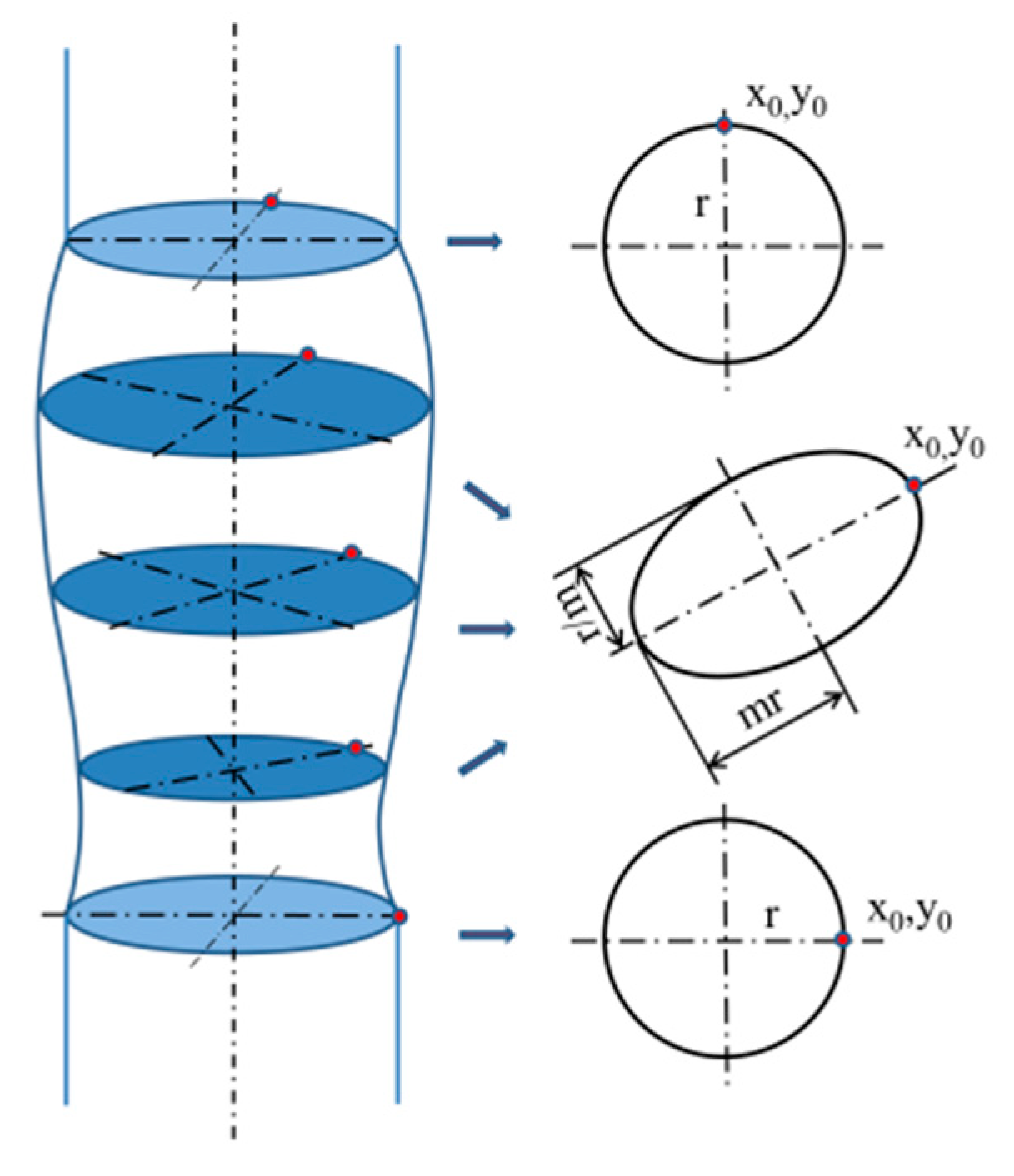
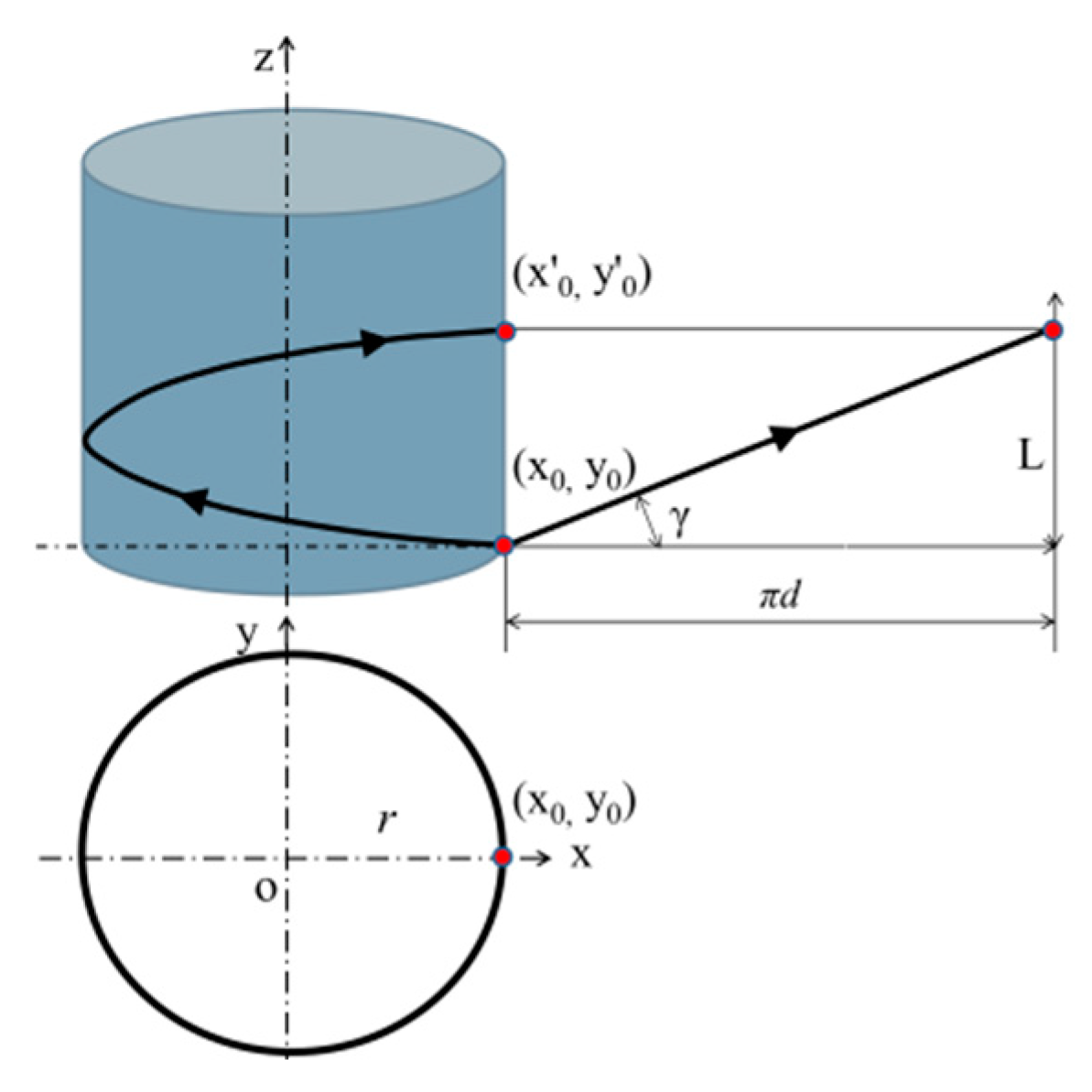
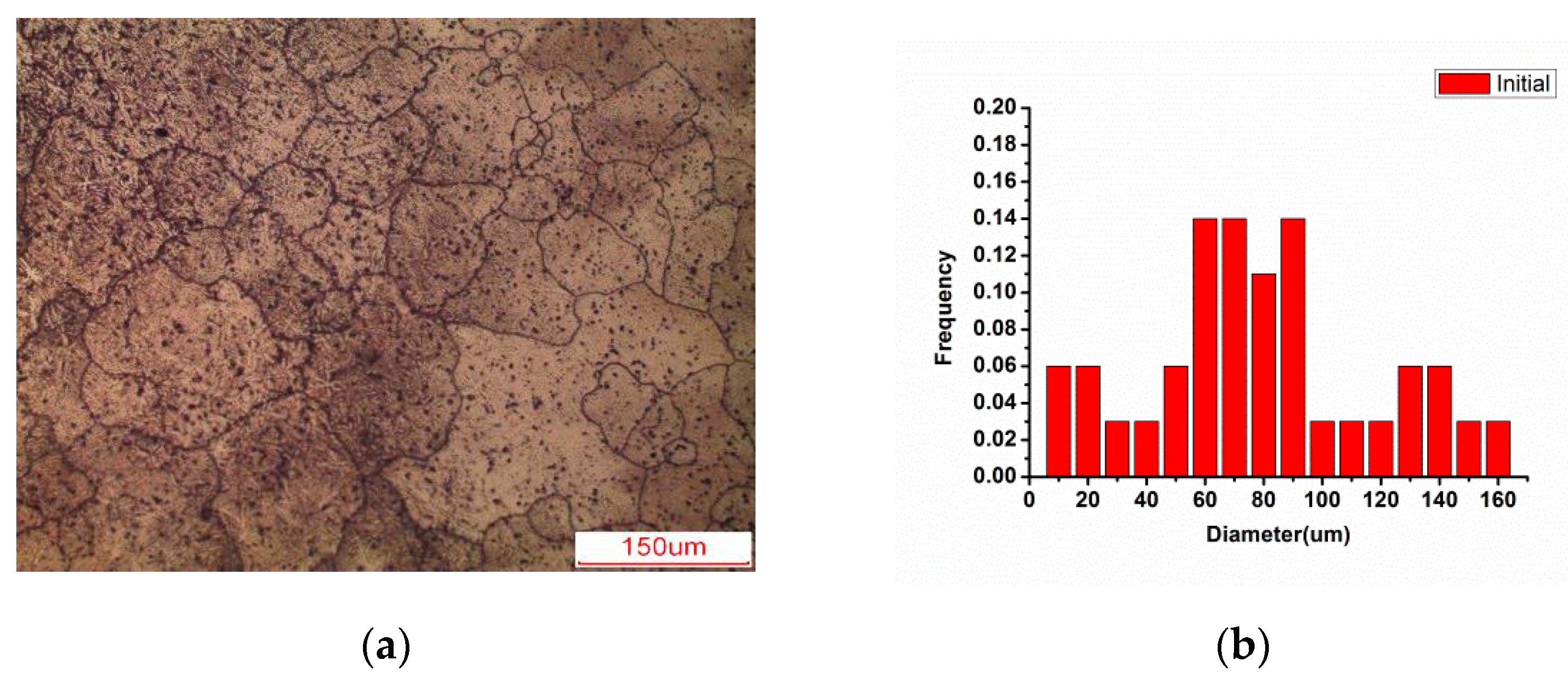
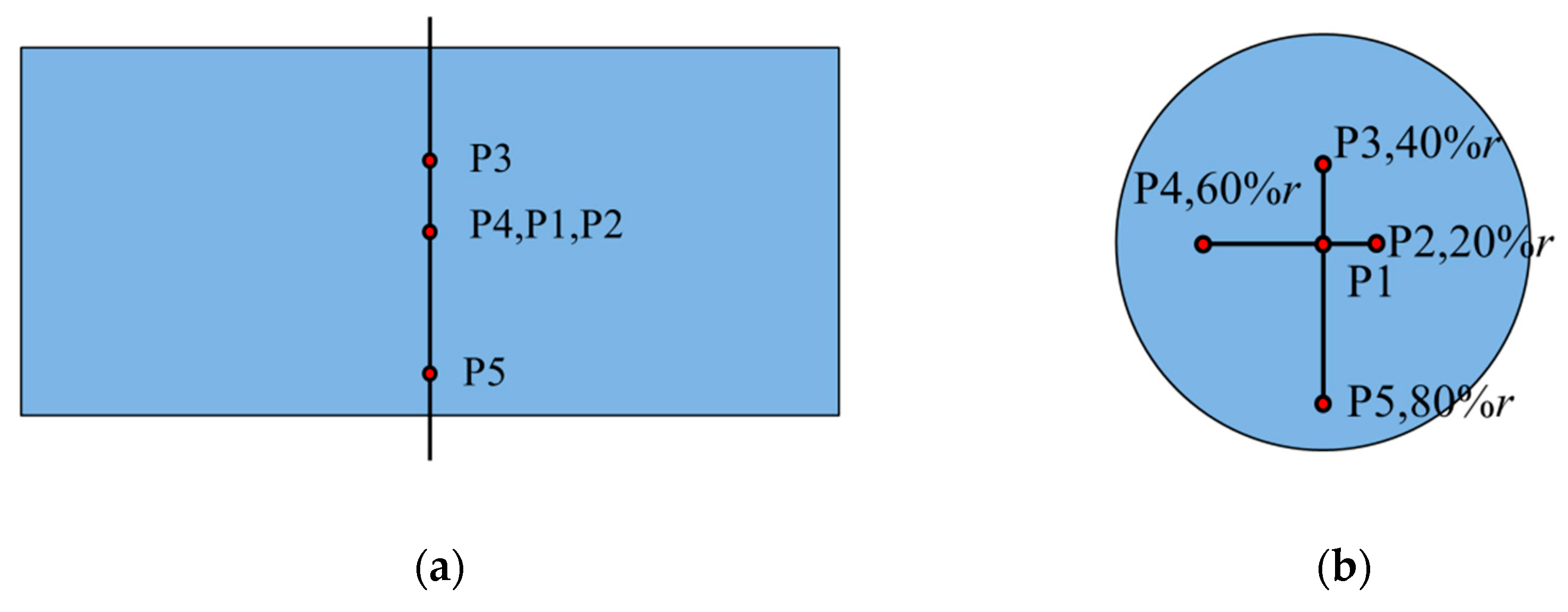
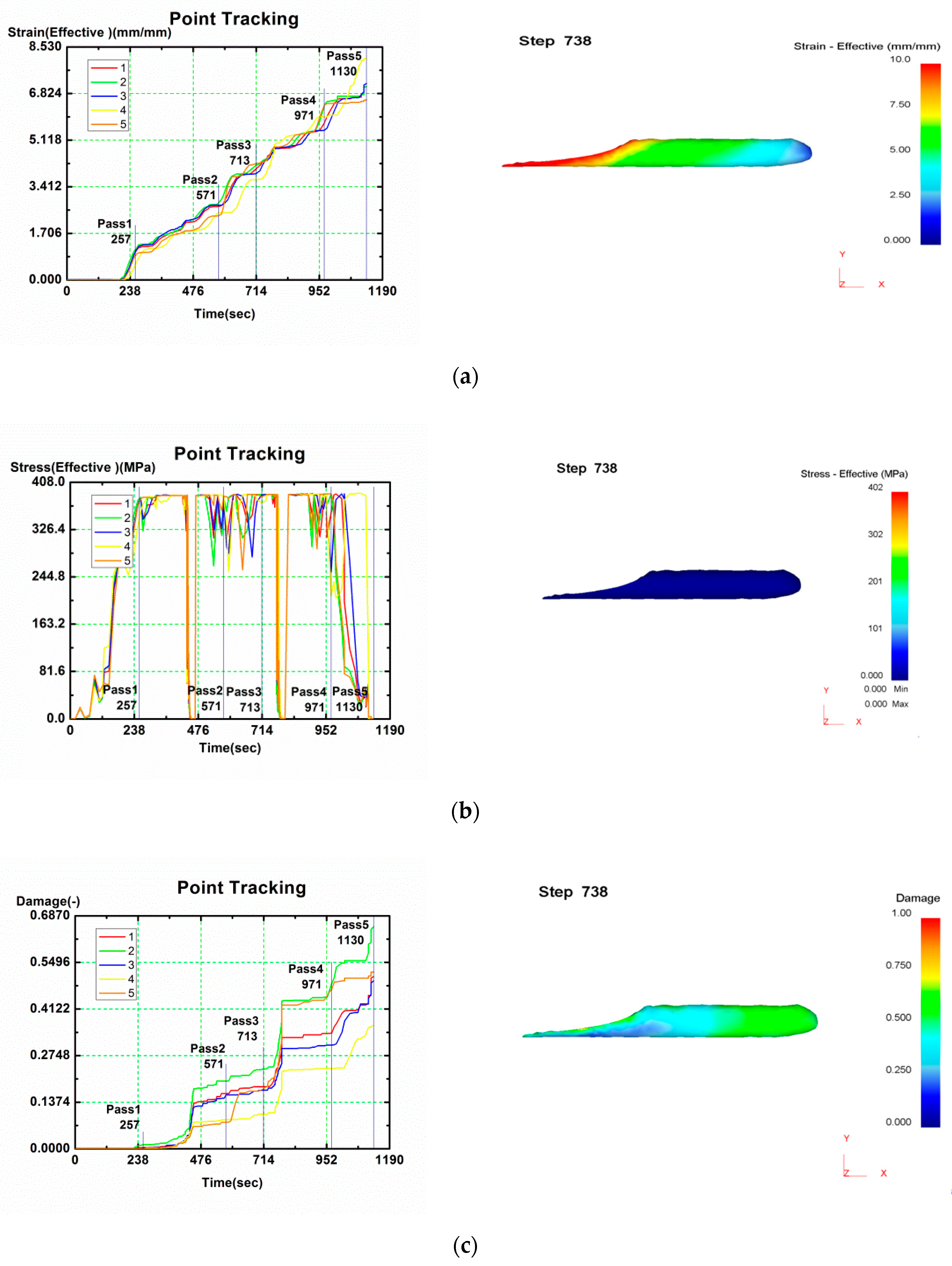
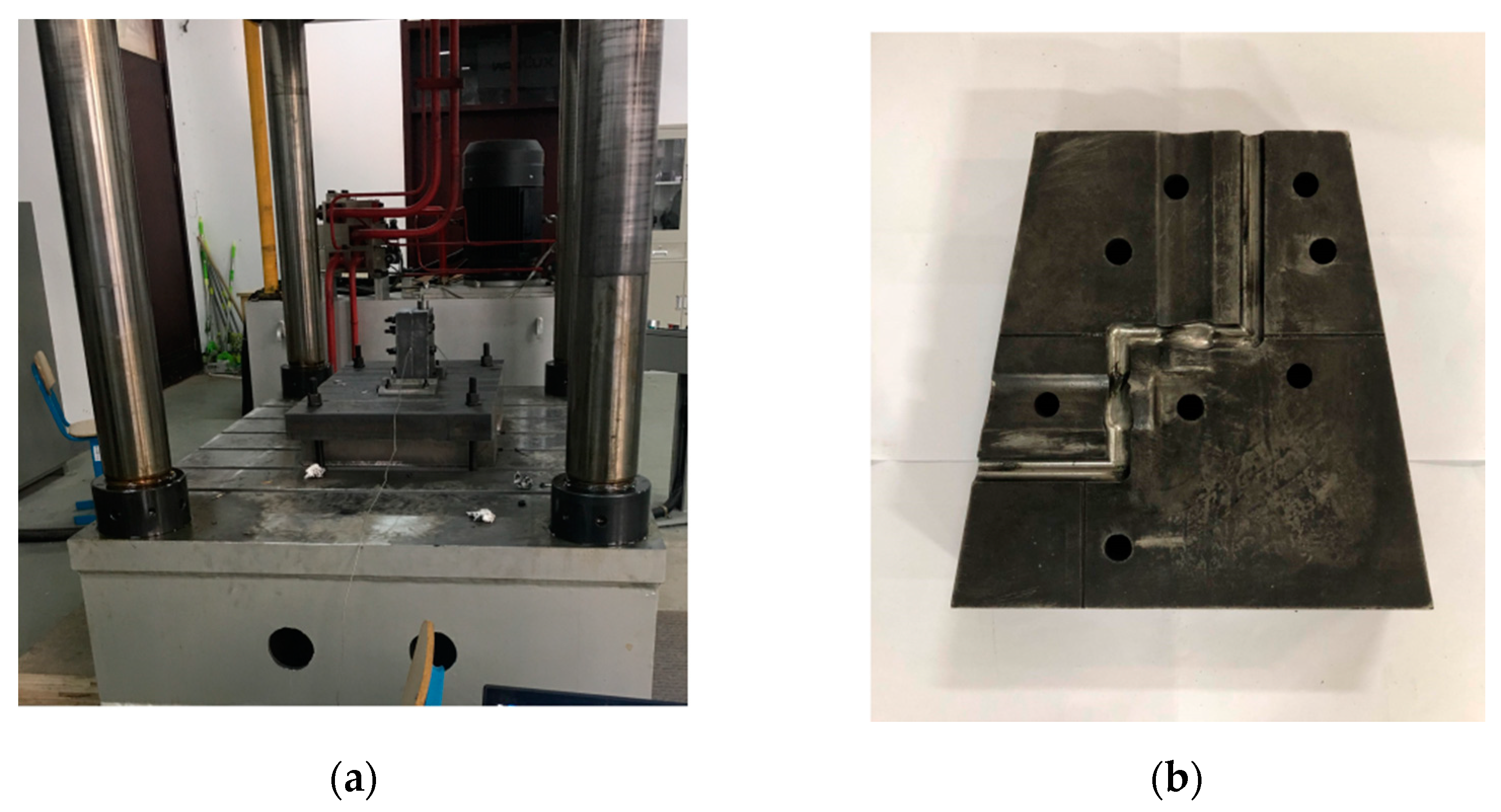

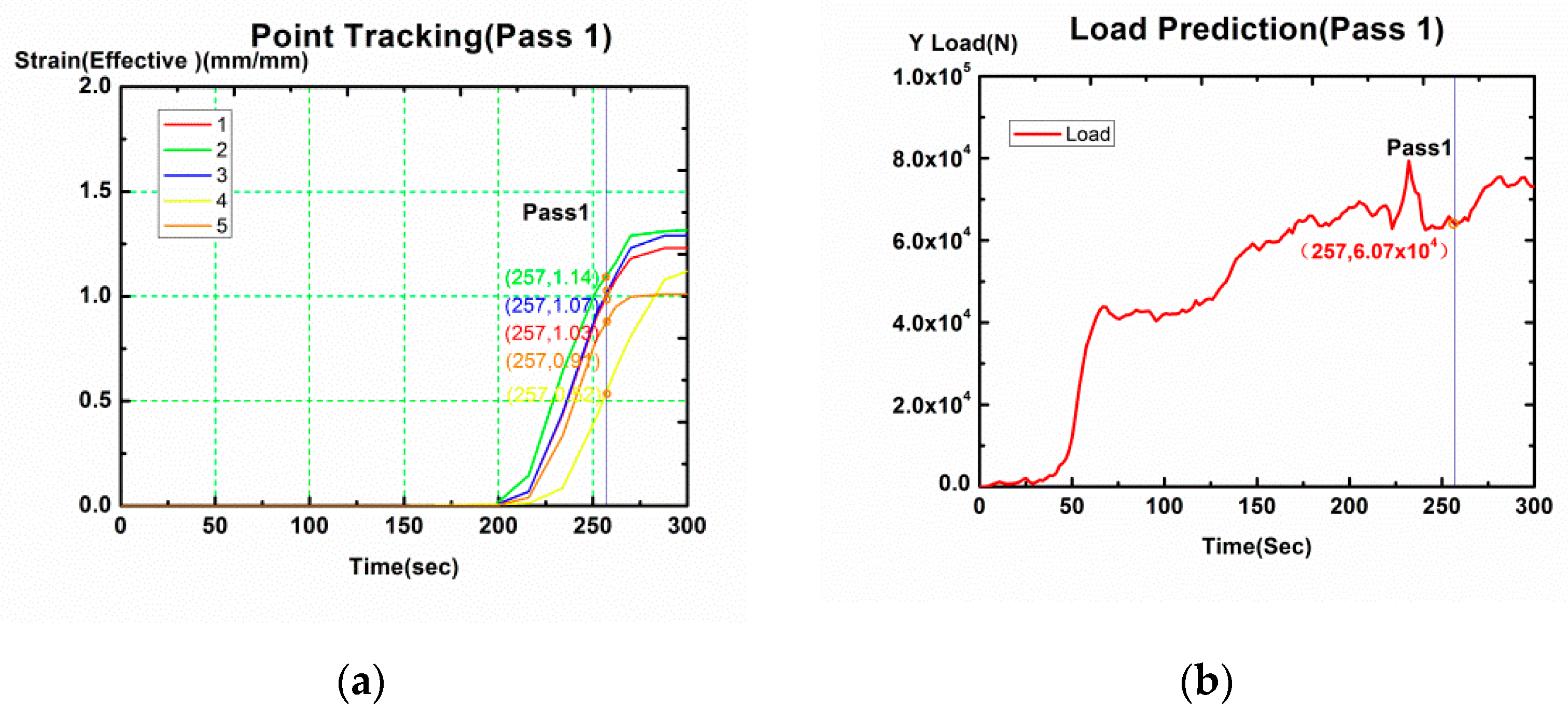

| Five Factors | (°) | (°) | (°) | L1 | ||
|---|---|---|---|---|---|---|
| Four Levels | 90,100, 110,120 | 10,20, 30,40 | 60,67, 73,80 | 1.2,1.25, 1.35,1.4 | 1d,1.17d, 1.32d,1.5d | |
| Test No. | ||||||
| 1 | 90 | 10 | 60 | 1.2 | 1 d | |
| 2 | 90 | 20 | 67 | 1.25 | 1.17 d | |
| 3 | 90 | 30 | 73 | 1.35 | 1.32 d | |
| 4 | 90 | 40 | 80 | 1.4 | 1.5 d | |
| 5 | 100 | 10 | 67 | 1.35 | 1.5 d | |
| 6 | 100 | 20 | 60 | 1.4 | 1.32 d | |
| 7 | 100 | 30 | 80 | 1.2 | 1.17 d | |
| 8 | 100 | 40 | 73 | 1.25 | 1 d | |
| 9 | 110 | 10 | 73 | 1.4 | 1.17 d | |
| 10 | 110 | 20 | 80 | 1.35 | 1 d | |
| 11 | 110 | 30 | 60 | 1.25 | 1.5 d | |
| 12 | 110 | 40 | 67 | 1.2 | 1.32 d | |
| 13 | 120 | 10 | 80 | 1.25 | 1.32 d | |
| 14 | 120 | 20 | 73 | 1.2 | 1.5 d | |
| 15 | 120 | 30 | 67 | 1.4 | 1 d | |
| 16 | 120 | 40 | 60 | 1.35 | 1.17 d | |
| Cu | Mg | Mn | Fe | Si | Zn | Ti | Cr | Al |
|---|---|---|---|---|---|---|---|---|
| 4.2 | 1.3 | 0.6 | 0.5 | 0.5 | 0.25 | 0.15 | 0.1 | Bal. |
| E | A | |||
|---|---|---|---|---|
| 66 GPa | 95 MPa | 177 MPa | 33.7 | 29.4 |
| No. | Effective Strain | Damage Indicator | Effective Stress (MPa) | Deformation Homogeneity Coefficient (DHC) |
|---|---|---|---|---|
| 1 | 8.7794 | 0.4705 | 388.35 | 0.4510 |
| 2 | 6.9816 | 0.5727 | 386.86 | 0.1874 |
| 3 | 7.171 | 0.8286 | 388.03 | 0.0867 |
| 4 | 6.444 | 0.6584 | 387.77 | 0.0907 |
| 5 | 4.2443 | 0.1774 | 386.89 | 0.0896 |
| 6 | 6.4982 | 0.1934 | 387.57 | 0.3820 |
| 7 | 4.2519 | 0.4982 | 387.12 | 0.0962 |
| 8 | 5.2012 | 0.4858 | 387.54 | 0.1100 |
| 9 | 5.6506 | 0.434 | 387.64 | 0.0676 |
| 10 | 4.5922 | 0.3971 | 387.27 | 0.0761 |
| 11 | 6.0053 | 0.5357 | 387.65 | 0.1332 |
| 12 | 4.6802 | 0.5334 | 387.28 | 0.1932 |
| 13 | 3.4861 | 0.5405 | 386.79 | 0.0795 |
| 14 | 3.7979 | 0.5586 | 386.85 | 0.0854 |
| 15 | 5.5861 | 0.4655 | 387.69 | 0.0701 |
| 16 | 6.9767 | 0.5272 | 388.21 | 0.0715 |
| No. | Grey Relational Generation | Grey Relational Coefficients | Grey Relational Grades | |||||||
|---|---|---|---|---|---|---|---|---|---|---|
| Normalized Effective Strain | Normalized Damage | Normalized Effective Stress | Normalized DHC | Optimal Normalized Value | Effective Strain | Damage | Effective Stress | DHC | ||
| 1 | 1 | 0.5499 | 0 | 0.1020 | 1 | 1 | 0.5263 | 0.3333 | 0.3577 | 0.5543 |
| 2 | 0.6604 | 0.3930 | 0.9551 | 0.2688 | 1 | 0.5955 | 0.4517 | 0.9176 | 0.4061 | 0.5927 |
| 3 | 0.6961 | 0 | 0.2051 | 0.0873 | 1 | 0.6220 | 0.3333 | 0.3861 | 0.3539 | 0.4238 |
| 4 | 0.5588 | 0.2614 | 0.3718 | 0 | 1 | 0.5312 | 0.4037 | 0.4432 | 0.3333 | 0.4279 |
| 5 | 0.1432 | 1 | 0.9359 | 1 | 1 | 0.3685 | 1 | 0.8864 | 1 | 0.8137 |
| 6 | 0.5690 | 0.9754 | 0.5 | 0.9211 | 1 | 0.5371 | 0.9532 | 0.5 | 0.8637 | 0.7135 |
| 7 | 0.1447 | 0.5074 | 0.7885 | 0.1495 | 1 | 0.3689 | 0.5037 | 0.7027 | 0.3702 | 0.4864 |
| 8 | 0.3240 | 0.5264 | 0.5192 | 0.3596 | 1 | 0.4252 | 0.5136 | 0.5098 | 0.4385 | 0.4718 |
| 9 | 0.4089 | 0.6060 | 0.4551 | 0.2838 | 1 | 0.4583 | 0.5593 | 0.4785 | 0.4111 | 0.4768 |
| 10 | 0.2090 | 0.6626 | 0.6923 | 0.1709 | 1 | 0.3873 | 0.59710 | 0.6190 | 0.3762 | 0.4949 |
| 11 | 0.4759 | 0.4498 | 0.4487 | 0.4967 | 1 | 0.4882 | 0.4761 | 0.4756 | 0.4983 | 0.4846 |
| 12 | 0.2256 | 0.4533 | 0.6859 | 0.4644 | 1 | 0.3923 | 0.4777 | 0.6142 | 0.4828 | 0.4918 |
| 13 | 0 | 0.4424 | 1 | 0.2518 | 1 | 0.3333 | 0.4728 | 1 | 0.4006 | 0.5517 |
| 14 | 0.0589 | 0.4146 | 0.9615 | 0.3105 | 1 | 0.3470 | 0.4607 | 0.9286 | 0.4203 | 0.5391 |
| 15 | 0.3967 | 0.5576 | 0.4231 | 0.7207 | 1 | 0.4532 | 0.5306 | 0.4643 | 0.6416 | 0.5224 |
| 16 | 0.6594 | 0.4628 | 0.0897 | 0.8054 | 1 | 0.5948 | 0.4821 | 0.3545 | 0.7199 | 0.5378 |
| Segregated Grey Relational Grade | Contribution Order | ||||||
|---|---|---|---|---|---|---|---|
| 1 | 2 | 3 | 4 | ||||
| 0.5809 | 0.6396 | 0.5831 | 0.6403 | 0.0034 | 2 | ||
| 0.6618 | 0.6351 | 0.5823 | 0.5648 | 0.0061 | 1 | ||
| 0.5724 | 0.6410 | 0.6041 | 0.6265 | 0.0027 | 3 | ||
| m | 0.5861 | 0.6113 | 0.6484 | 0.5982 | 0.0022 | 4 | |
| L1 | 0.5910 | 0.6208 | 0.5910 | 0.6412 | 0.0018 | 5 | |
| Effective Strain | Damage | Effective Stress (MPa) | Deformation Homogeneity Coefficient |
|---|---|---|---|
| 7.2098 | 0.5085 | 388.2251 | 0.2131 |
Publisher’s Note: MDPI stays neutral with regard to jurisdictional claims in published maps and institutional affiliations. |
© 2020 by the authors. Licensee MDPI, Basel, Switzerland. This article is an open access article distributed under the terms and conditions of the Creative Commons Attribution (CC BY) license (http://creativecommons.org/licenses/by/4.0/).
Share and Cite
He, M.; Wang, Q.; Yang, F.; Shi, D. Study of HCAP-PC to Enhance Process Efficiency for Age-Hardened Aluminum Alloys Based on Grey Relational Analysis. Metals 2020, 10, 1594. https://doi.org/10.3390/met10121594
He M, Wang Q, Yang F, Shi D. Study of HCAP-PC to Enhance Process Efficiency for Age-Hardened Aluminum Alloys Based on Grey Relational Analysis. Metals. 2020; 10(12):1594. https://doi.org/10.3390/met10121594
Chicago/Turabian StyleHe, Min, Qili Wang, Feng Yang, and Duanhu Shi. 2020. "Study of HCAP-PC to Enhance Process Efficiency for Age-Hardened Aluminum Alloys Based on Grey Relational Analysis" Metals 10, no. 12: 1594. https://doi.org/10.3390/met10121594
APA StyleHe, M., Wang, Q., Yang, F., & Shi, D. (2020). Study of HCAP-PC to Enhance Process Efficiency for Age-Hardened Aluminum Alloys Based on Grey Relational Analysis. Metals, 10(12), 1594. https://doi.org/10.3390/met10121594




